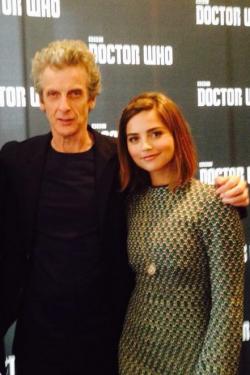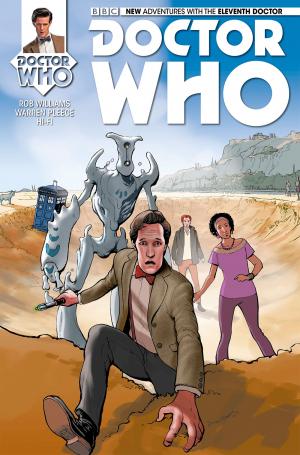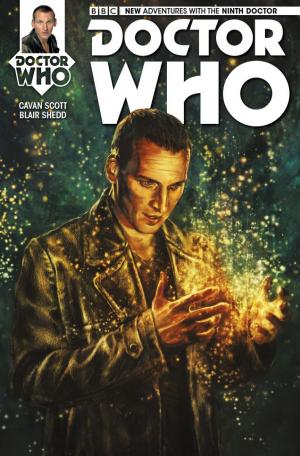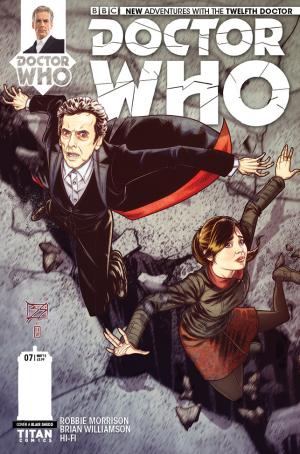
Peter, being a die-hard Doctor Who fan yourself,
were you nervous about living up to the huge expectations of the fans?
Peter: I was very nervous about playing
the part, but I didn’t really think about the expectations of the fans. Because
that’s not very useful. It would make me just more nervous. I just tried to
think about playing the part as best I could.
Does it take guts to alter this much-loved
character?
Peter: I don’t think he has altered much.
I just felt very privileged to play the role. But it was frightening and is frightening, but luckily Jenna has
been a fabulous support, help and friend to me and I was very lucky that she
was playing the role when I arrived. She made it a very enjoyable experience as
well as a challenging one.
So what was it like to see the TARDIS for the
first time?
Peter: I saw the TARDIS once while David
Tennant was the Doctor in an episode called Fires of Pompeii. I thought this
would be my only involvement with Doctor
Who. So I was very pleased that they asked me to be the Doctor. With Fires of Pompeii they offered me the part and I didn’t even read the script and said
that I just want to do this. But my wife said “No, you mustn’t. You are a
professional actor. You have to read the script and see what it’s like.” David
was great. He showed me the TARDIS which I found quite moving at the time but I
didn’t realise that a few years later I would be “driving” it myself. It is a
very wonderful place to be. And also I am realising how popular the show is
growing around the world and it’s interesting to go and meet the fans to see
how it’s going down in other countries.
Jenna, how would you characterise your relationship with the Doctor?
Jenna: I think Clara is his conscience and his moral compass. Perhaps even his school-teacher in his social skills, teaching him how to interact with humans. I think Peter’s Doctor is a lot more Alien than the Doctors we’ve seen before. Clara helps to integrate him. There is a lot of history between them. She is the companion who has been there throughout all of his regenerations. So she is the long-standing friend.
Can you tell us a little bit about your journey from Clara Oswald, the impossible girl, to the school-teacher?
Jenna: With the impossible girl we didn’t really know Clara like we know her now. She had to be kept a mystery from the audience and from the Doctor, so we couldn’t really get to close to her. Series 8 allowed us more freedom to see more of her life, her home and what she does away from the Doctor. Also to see her struggle with and enjoying the two different lives she leads. We could finally explore her domestic life a little bit more, whereas we are a lot more space-bound in the upcoming Series 9. It is a lot more about life in the TARDIS and visiting as many planets and places as they can to have reckless adventures.
Jenna and Peter, which characteristic of your roles do you like and which do you dislike?
Jenna: I kinda like my bad qualities. Clara is really flawed. Egotistical and stubborn. A control-freak. And at the same time she is kind, brave, adventurous and romantic. But I like the fact that she is totally flawed.
Peter: I don’t dislike any qualities of the Doctor. I like everything that he does. I like the fact that he is tricky and distant. Sometimes friendly, sometimes clumsy, sometimes arrogant. I like all of it. And all of them.
Were you certain that an older, darker Doctor would work from the beginning or were there doubts?
Peter: No. I had no idea. You can’t second-guess the audience. You can’t try to come up with a version of the Doctor that is just good for marketing. You have to find out how you feel as an actor about this role and try to be true to that. While at the same time, playing the role that Steven [Moffat] writes. Matt, who I absolutely loved, was a very accessible and friendly Doctor, so we automatically tried to be a little less of that. But I think that’s all right. I didn’t want to seek the audience’s approval. I think it’s important not to ask the audience to love you. They must find out for themselves whether they like you or not.
The show has grown in popularity all over the
world. Do you think it has something to do with changed viewing habits and new
ways to watch TV like online streaming?
Peter: Yes, the way that people watch
television is very different now. They can have access to all kind of
programmes through different platforms and can watch whenever and wherever they
like. So that helps a programme like ours, which is to some extend a kind of
“cult”. People tend to discover Doctor
Who and it’s a quiet, private thing and they don’t necessarily want it to
become a big fan-thing that other people know about. Especially because in its
history a lot of the time the show has been under-the-radar and people have
loved it without being validated. There were times when you felt like being
rebellious for being into it or you were not one of the cool kids for being a
fan. Now it’s really cool, which is nice!
What do you think is the main difference
between the new and the old show? Are the scripts today better than they used
to be?
Peter: Part of the joy of it is that we
make a programme that has the spirit of the old series but has the technical
prowess of the modern, digital age. We have CGI and wonderful make-up and
costumes. You couldn’t do the show today as it used to be done back in the
days. The old show was only ever meant to be watched when it was transmitted. That was it. There wasn’t even a video industry and the show
wasn’t expected to be examined in detail. An episode just existed for 25
minutes on a Saturday night. I get annoyed when some people say unkind things
about some of the production values. The early show didn’t have much money and
the makers didn’t have much time. But they had huge imagination. And it was the
imagination and the images that the show triggered in children that was
special. I was a child when Doctor Who
began and it fired my imagination.
Can you tell us some secrets of the upcoming
Series?
Jenna: Vikings!
Peter: Yes, Vikings. Very good!
Jenna: Our secret number one.
Peter: They are real Vikings! They are not Robot-Vikings or Space-Vikings.
Jenna: Actual Vikings!
Peter: In Viking times on Earth. Which is
great. And that’s when we meet…erm….some more Vikings. [Jenna and Peter laughing]
How scary is it for an actor to suddenly be the
face of such a phenomenon?
Jenna: I remember that Matt described it
to me like a freight-train that you jump on. And that’s what
happens. As soon as you start filming, you end up enjoying the job so much and
that you are going to work every day and the storytelling is so dynamic. It’s
almost too much fun. The filming part
just takes over.
Peter: I just sort of try not to look down.
If I become over-conscious of the scale and interest in the show it would
probably make me a difficult person to live
with. I don’t think it’s a very natural situation to be so recognised. I
asked David Tennant about what is going to change for me. He told me that I
will become incredibly visible. At home, in the Uk, that means when you go to
the Grocery Store or wherever you look like the Doctor, so people will look at
you all the time. But it’s fine. You receive a lot of affection.
You have been to Comic Con, doing conventions
and promotion, now you are here in Germany. How do you keep your energy up? Is
this side of your job still exciting or is it stressful?
Jenna: We drink a lot of coffee.
Peter: We do. And we are looked after by
our wonderful team from BBC Worldwide. To be honest, we are in the middle of
filming episode eleven right now. The production team has now been off on
holidays for two weeks. And we have gone to Comic Con and to L.A. and now to
Berlin. We don’t actually do that much. It takes nine months to film the show,
so that’s what we spend all our time on. But you are right, this here is a
different energy and a different way of being, that we have to get used to,
too. But I think it keeps you young. When I started the job I thought I will
get me an exercise bike, but it soon became clear that I didn’t need to do any exercise.
Working from 7 a.m. in the morning to 7 p.m. at night is better than going to
the gym.
Jenna, which Doctor would you like to hang out with
at a pub?
Jenna: I’m happy doing that with my
current Doctor. But if I had a TARDIS I would not go to the pub. I’d be on some
other planet somewhere. If you got all of time and space, I definitely wouldn’t be in a pub.
Can you tell us about your sweetest gift by a
fan or a fan encounter?
Jenna: I had very recently gotten a little
box from Rome and it was a wooden box with Clara’s leaf from Series 7 carved
into it. I thought it was really extraordinary.
Peter: I popped into the Doctor Who Experience once. I had this
Saturday off and I thought of what I could do this day. So I decided it is
going to be Doctor Who at the Doctor Who
Experience. My wife actually persuaded me to do it. She said “you are going
to make a lot of people very happy”. And I did. But they made me so happy, just by their affection.
There were hundreds of fans and more kept on coming. I was kneeling down
because I had my photograph taken with some children and suddenly this little
girl screamed “Doctor Who”. And she
came running and threw her arms around my neck. She was very small and she
totally believed in Doctor Who. It was absolutely lovely. That was a wonderful
experience. You are at the centre of a child’s utter believe in the magic of
this character.
Jenna: The day before I started filming – no
one knew I was a companion yet – I was walking around in London and suddenly
heard the word “Cardiff”. I turned around and saw this little boy, fully
dressed up as the Doctor with his Sonic Screwdriver. The chances of this happening,
a day before filming… That was very sweet.
Have you taken any props from the set which no
one knows about?
Jenna: I’ve been trying for so long.
Peter: She is always trying to steal
stuff.
Jenna: I haven’t taken anything. But I
want to. I want to steal some stuff.
Peter: I don’t take anything. Well, they
need it.
Jenna: [laughs] Some bits from the TARDIS.
I usually ask if there are any replacements before I try to steal them. There
isn’t, so I cannot do it.
Peter, does your Doctor develop a catchphrase
this series?
Peter: Catchphrase? I’m not interested in
catchphrases. The Doctor never used to have a catchphrase. That is a fairly new
development.
Jenna: “Shut up”?
Peter: Shut up?
Jenna: Someone was asking you to write that
down recently.
Peter: Oh, yeah. But I don’t need a
catchphrase.
There is a big discussion going on about budget
cuts at the BBC. Do you think this will have any impact on Doctor Who?
Peter: Probably, at some point. It’s all
in such a state of flux. The thing about Doctor
Who is, it is a very powerful money-maker for the BBC. So hopefully it will
be looked after. It would be silly to reduce the quality of what we are making.
It is bringing so much more money back in and all that money is used to make
other programmes. Not Doctor Who. [laughs]
So what do you both watch on TV?
Jenna: We watch…
Peter: Not together….
Jenna: No, not together. Game of Thrones. Mad Men. I really like Black Mirror and Inside No 9. Masters of Sex.
Was there a moment when you thought the Doctor
and Clara found their groove?
Jenna: I think at the end of episode one.
Not found our groove, but for me there was a moment of something different and
new. We connected.
Peter: I felt very connected to Jenna right
from the start because she made me feel so welcome. She looked after me. The
nice thing is, we were both very conscious of not getting into a groove. We
wanted to explore these characters as thoroughly as we could, so we were trying
to not go to a place where we would feel too comfortable. That was the point of
their story. They get to know each other as we were.
Will Series 9 continue to focus on the
characters like Series 8 did? Last year we had the Doctor finding himself and Clara finally
becoming a well-rounded character.
Jenna: They are a lot more united now and
just enjoy the moment and the adventure. We are doing two-parter episodes as
well this year, which is new. So we can have cliffhangers and explore the
stories, the places and the characters for longer. I feel like we definitely
moved into a different place this year.
Peter: I think they are much more bonded.
The Doctor wants to enjoy himself with his wonderful friend. The thing that is
tricky about the Doctor and his relationship with companions… You know,
Christopher Eccleston says in his first episode “I can see…everything. All there
has ever been and all there ever will be. And that drives me mad”. So in a way,
the Doctor knows the fate of all of his companions. That makes it…difficult.
But in this instance he is deliberately enjoying the relationship and this
great toybox of time and space that they can explore together. But of course,
as it’s Doctor Who, there is an ever
deepening shadow pursuing them.
Will you both be back for Series 10?
Jenna: We haven’t read the script to
episode 12 yet.
Peter: No, we haven’t got to the end of
this series. So we don’t know yet what happens to us.
Thank you very much for the interview!






 Writer - Cavan Scott,
Writer - Cavan Scott, STORY BY: Robbie Morrison
STORY BY: Robbie Morrison Written by Alan Barnes
Written by Alan Barnes Circle us on Google+
Circle us on Google+